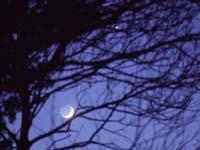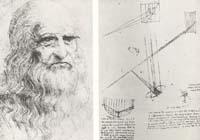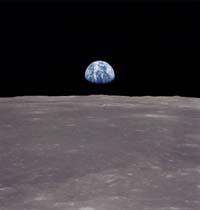Reflection of the Earth on the Moon
2006/04/09 Galarraga Aiestaran, Ana - Elhuyar Zientzia

For example, during sunset, and when the Moon is rising, sometimes a blurred image of the full Moon is perceived. If necessary, you have also seen it on the crescent moon that has passed now, and perhaps you have not wondered. You enjoyed the show and point. For the XVI. In the 19th century, Leonardo da Vinci wanted to know what this mysterious light causes.
Currently the answer is quite simple: Earth is the cause of the weak image of the Full Moon. In fact, when the Sun enters the Moon, the Moon darkens, but not at all, because there is still another source of light shining in the sky, the Earth. In fact, the Full Moon illuminates the night of the Moon 50 times brighter than the Earth.
Leonardo, light man

Five centuries ago, however, much imagination was needed to suspect that the brightness of the Earth illuminated. They did not know that the Earth revolved around the Sun, as Copernicus's theory was published after Leonardo's death. But Leonardo had a lot of imagination, more than a lot, a lot.
He was a good painter and made wonderful drawings. Many of them had to do with science. Some were extremely fantastic, unexecutable at the time, such as flying, underwater, helicopter or robot machines. Through other drawings, he explained how some phenomena of nature and the human body work. For him, all aspects of science were interesting: engineering, mathematics, anatomy, biology, architecture, geology, mechanics, physics... and astronomy.
Thus, around 1510, in the codex Leicester, he wrote a sheet with a curious title: “On the moon: there are no solid bodies that are lighter than air.” There he explained that the Moon has atmosphere and seas. In his opinion, the Moon must the seas be so good reflector. He also wrote that the sunlight on Earth is the result of the reflection of the seas on the Moon in the Crescent. The explanation was accompanied by a diagram.
Leonardo was wrong in two things. On the one hand, the Moon has no sea and, on the other, the seas are not the main generators of the brightness of the Earth, but clouds. In fact, the oceans only reflect 10% of the sunlight they receive, while the Earth represents between 10-25% and clouds over 50%. While snow and ice reflect more light than clouds (40-90%), snowy areas are often under clouds, so the Earth owes its brightness to the light reflected by clouds.
An opportunity

From the Moon, the Earth looks 4 times wider than the Sun and shines 50 times wider than the full Moon. (Photo: Recent searches
On the New Moon the Moon is not seen from Earth, but on the Moon it is a earth, that is, the Earth illuminates the Moon with all its splendor. From that moment, from night to night, at first it appears very fine but increasingly full in the sky. If we look well, it is time to detect the brightness of the Earth.
In addition, in recent years scientists are paying special attention to the reflection of the Earth on the Moon, in order to calculate the amount of light that reflects the Earth. It is related to global warming. The truth is that scientists have discovered that the brightness of the Earth is 10% higher than the average in April and May. So, unless clouds prevent it, this is a good time to look for the brightness of the Earth on the Moon. A good excuse to look at the Moon!
Published in 7K.




